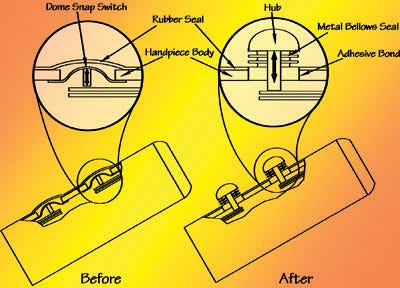January 12, 2005
Originally Published MPMN January 2005
PROFILE
Cuts Better Than a Knife
Metal bellows seals out leaks in improved electric scalpel
|
Click to enlarge. |
Electric-powered surgical instruments can perform miracles on patients, but not if they leak around the seals.
That is exactly the problem designers faced when prototyping an improved electrical scalpel. The idea was to move electrical control from foot pedals to push buttons right on the handpiece, giving surgeons greater control and sensitivity. The handpiece contained two control buttons. One was for high and low speed and the other controls multiple gripping positions.
Trouble was, the handpieces required autoclaving after each use, causing the rubber switch seals to leak. The seal design consisted of a rubber membrane over a dome-type snap switch, much like the switch
on today’s most popular electric toothbrushes. The arrangement on the handpiece prototype was leakproof at ambient temperature and pressure, but not at the typical heat-and-vacuum cycles of steam autoclaving.
Under vacuum, the membrane stretched and became porous due to the negative pressure gradient set up between the inside and outside of the handpiece. Then, as the vacuum was released, rising chamber pressure drove residual moisture through the seal, ruining the electrical contacts inside. In fact, rubber seals in the prototypes sprang leaks during the very first autoclaving cycle.
The solution was a metal bellows-type switch seal assembly from Servometer (Cedar Grove, NJ; www.servometer.com). Designers called Servometer to see if a metal bellows solution would work.Servometer then collaborated with the instrument maker on a redesign that solved the problem entirely. In fact, the handpieces are now good for thousands of use and autoclaving cycles.
Success of the redesign hinged on a “thumbtack-within-a-bellows” assembly. A push button shaped like a thumbtack is soldered to the top of the bellows, whose bottom then fastens and seals mechanically to the handpiece body. This creates a total hermetic seal for the switches.
The push button has an actuator pin on its underside, not unlike the shaft of a thumbtack. The surgeon’s pressure on the button compresses the bellows like a spring, engaging and closing the electrical spring contacts inside the handpiece body. When the surgeon eases up, the bellows recovers, breaking the circuit.
The push button is a one-piece stainless-steel screw-machined part; the bellows is electrodeposited nickel. The entire push button assembly measures only 0.200 in. high by 0.312 in. diam. Bellows walls measure just 0.0005 in. thick.
The walls didn’t start out that thin, though. When surgeons tried the first redesigned prototype, they found the new switches a little too stiff, or hard to depress. So Servometer slenderized the bellows walls by 0.0002 in. to pare the spring rate and improve the touch.
“That’s one design advantage of electrodeposited bellows,” says Paul Hazlitt, Servometer’s director of engineering, who partnered in the redesign. “Convolutions can be much finer and walls much thinner than in press-formed bellows. We can fine-tune the touch, and still provide an absolute dynamic hermetic seal. Electrodeposited bellows can be made as conformable as a Slinky toy.”
For antiseptic and corrosion-resistance reasons, the entire bellows-actuator assembly is gold plated. Servometer provided the complete plated bellows-and-push button assembly.
Copyright ©2004 Medical Product Manufacturing News
You May Also Like



